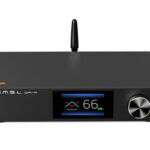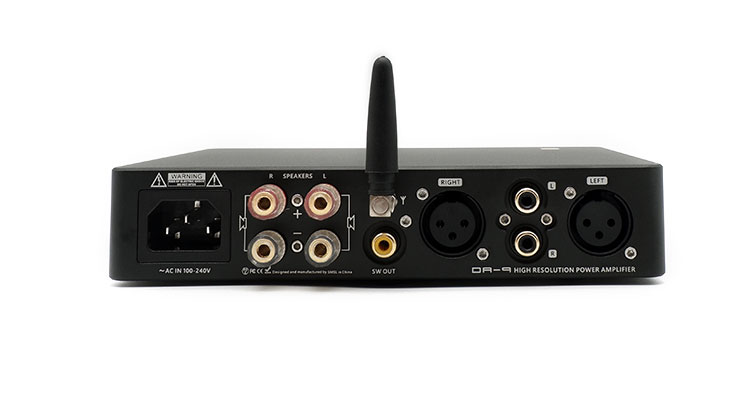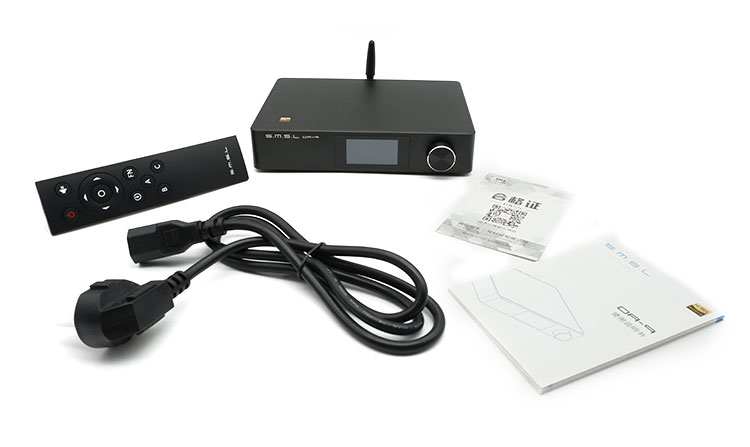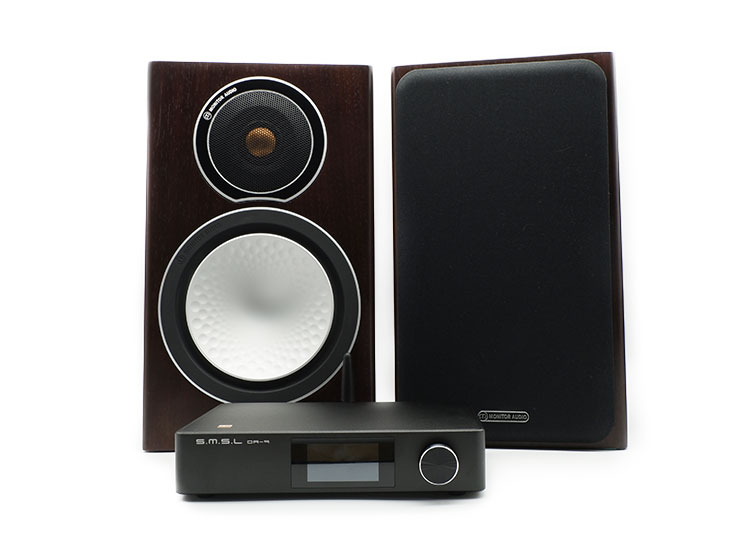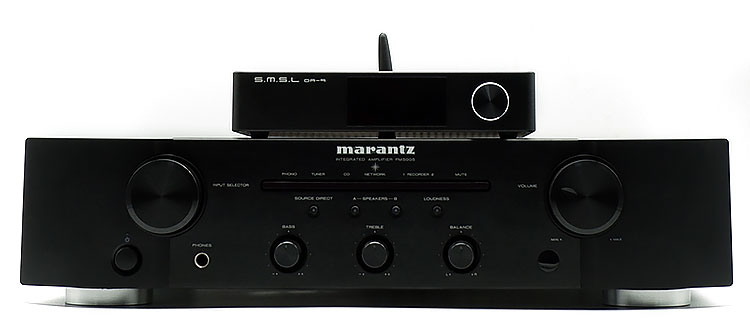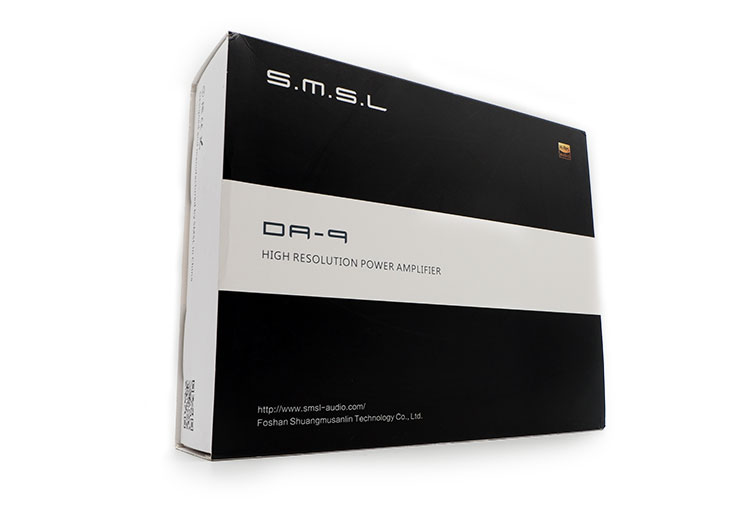The SMSL DA-9 is a desktop power amplifier featuring Bluetooth 5.0, aptX decoding, and capable of up to 90W into 4Ω. It is priced at $249.99
Disclaimer: The SMSL DA-9 sent to us for this review is a sample in exchange for our honest opinion. We thank Shenzhen Audio for giving us this opportunity.
To read more about SMSL products we have reviewed on Headfonics click here.
Note, this review follows our new scoring guidelines for 2021 which you can read up on here.
We have been working with SMSL for quite a while already, and have had the privilege to review a lot of their products. This includes their entry-level M100 MkII DAC, and even their upper mid-range DAC, the M400, as well as SMSL’s wide range of headphone amplifiers that include the SH-9 and SP400.
Of course, SMSL has been working on their 2-channel systems as well, and this time, they have sent us their DA-9 2-channel amplifier. Their DA-9 is a 2-channel speaker amplifier that is designed to work together as a triple stack together with the SU-9/SH-9 stack that we have reviewed last year.
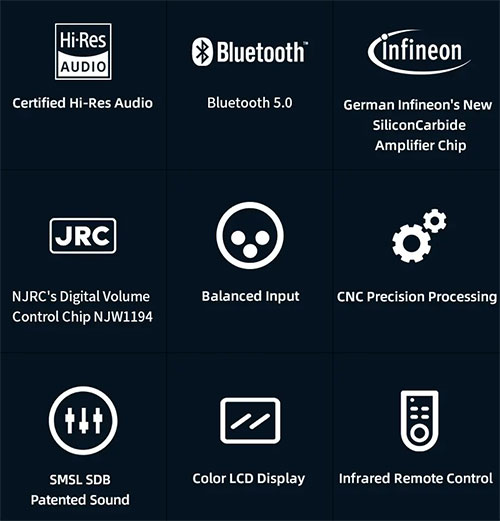
Tech Highlights
The DA-9 is a 2-channel amplifier equipped with a fully balanced circuit that greatly reduces signal distortion. Each channel is equipped with an Infineon class D amplifier circuit that ensures further reductions in distortion, as well as an efficiency of 92%, reducing power consumption.
To control the power that is produced by the DA-9, it is equipped with NJRC’s NJW1194 volume control IC. This ensures that the DA-9 will have channel balance throughout the entire volume range, as well as linear power output as it ramps up throughout the volume range.
Powering all this is a medical-grade power supply module that can provide up to 300W of instantaneous power, for superior dynamics and shielding from electromagnetic interference. The power supply circuit is also equipped with a large-frame, low-leakage switching power transformer that performs better than most off-board standard switch-mode power supplies.
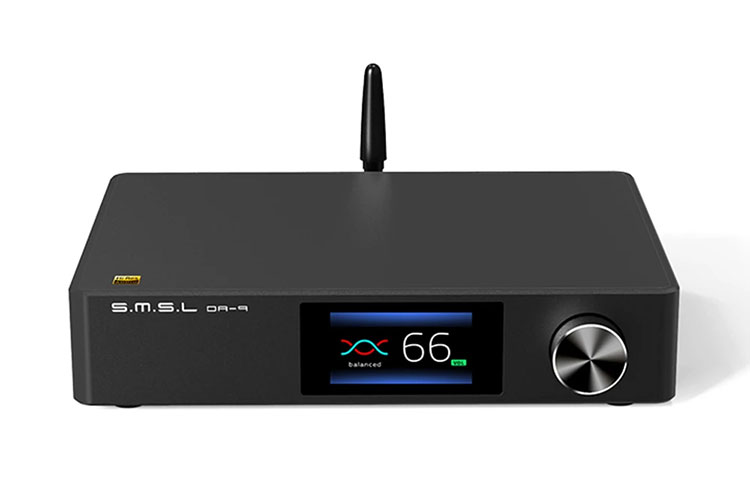
Design
Externally the DA-9 pretty much looks like both the SU-9 and the SH-9, where all 3 have the same physical dimensions.
The chassis of the DA-9 is made of the same aluminum material that is painted in the same matte black finish as both the SU-9 and the SH-9. The DA-9’s front fascia looks similar to the SU-9, where there’s just a screen and a volume dial that acts as the menu navigator for the DA-9.
The DA-9 still sports 3 rubber feet instead of the more traditional 4. This arrangement was mostly acceptable with both the SU-9 and the SH-9 because both devices don’t usually have heavy wires hanging at the back of the device. With the DA-9, it can pose as a bit of an issue if heavier gauge speaker wires will be sticking out of the rear of the DA-9.
With the DA-9’s dimensions being restricted to be the same as both the SU-9 and SH-9, the feature-packed DA-9’s rear panel gets slightly crowded particularly at the speaker terminals. With the crowded speaker terminals, it would be difficult to insert speaker wires directly into the speaker terminals, so having banana jacks would make setup time significantly more convenient.
I/O
I initially thought that the DA-9 is designed to rely on the SU-9 for inputs. However, the DA-9 is not limited to being connected to the SU-9, since it is equipped with a capable Bluetooth receiver. The on-board Bluetooth receiver is capable of Bluetooth 5.0 and supports hi-res codecs such as UAT, LDAC, and AptX HD
Aside from the Bluetooth input, the DA-9 also features both a single-ended RCA input and a balanced 3-pin XLR input. These input options can be switched using the included remote control, or the menu options in the on-screen menu.
Since the DA-9 is a 2-channel amplifier, it’s equipped with a pair of speaker terminals that can output 50W into 8Ω, 90W into 4Ω, and it even has a 2Ω rating with a maximum output of 150W. Aside from the standard 2-channel speaker output, the DA-9 also features a subwoofer output, ready for output to a powered subwoofer for a more complete 2.1 system.
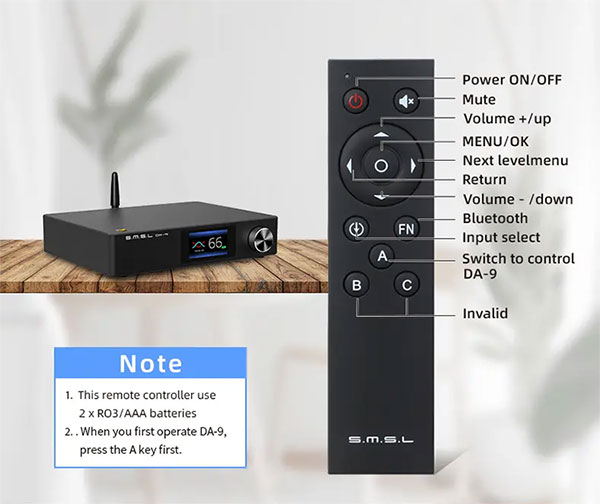
Interface
With the DA-9, there is a screen in the middle of the front fascia, that shows the status of the device. By default, it shows the input being used, as well as the volume setting of the device.
Pressing the volume knob takes you into the menu options, and pressing the volume knob again will take you deeper into the menu. There are menu options for input, EQ, tone controls for both bass and treble, soft clipping, and then finally there’s an option for display brightness adjustment.
Unfortunately, I didn’t find any subwoofer controls, so there are no controls for the cutoff frequency or the output level of the subwoofer.
Remote Control
Aside from manually adjusting using the volume knob on the DA-9, the DA-9 also comes with remote control. The provided remote control with the DA-9 works with both the SU-9 and the SH-9 too, so it’s possible to control the triple stack with just 1 remote in your hand.
The remote control has 3 buttons at the bottom, where pressing the A button will switch the remote to control the DA-9. By default, the up and down buttons control the volume of the device. Pressing the center of the directional keys will take you into the menu, and the directional buttons can be used to navigate the entire menu of the DA-9.
Going through the menu navigation with the remote control is a bit more convenient than using the volume knob because it has a back functionality.
Packaging & Accessories
The DA-9 arrived with SMSL’s standard packaging, with a sleeve that protects the inner box. The inner box is a white flip box, lined with foam inserts that keeps the DA-9 secure during storage and transport.
Inside the box, there’s the DA-9, a standard IEC power cable, the Bluetooth antenna, and the remote control. Aside from Bluetooth, there isn’t much in terms of connection to any upstream device, this packaging is what comes standard with most amplifiers.
Sound Impressions
(Sound impressions were completed with the DA-9 in tandem with an SMSL SU-9 DAC and Monitor Audio Silver 1 speakers).
Summary
With the DA-9 being a class-D amplifier, I expected it to be on the thinner side and this is exactly what I got with the Direct EQ mode. Good thing the DA-9 has some built-in EQ presets, as well as an option to manually adjust tone controls.
Direct mode gave the most neutral presentation, but it ended up making my system sound a bit too lean and counterclockwise tilted without a properly tuned subwoofer.
There are various tuning presets available with the DA-9, but they are just frequency response tunings. Interestingly, the DA-9 has an SDB mode, and it sounded significantly better than most of the other tuning filters.
It seems that the SDB mode implements a version of the Fletcher-Munsen curve compensation that seems to compensate for the perceived lack of bass and treble at lower volumes, while retaining a perception of neutrality, giving a clear sense of midrange presence.
Bass
Bass through the DA-9 has a good amount of sub-bass extension, and there is a good sense of mid-bass attack. However, when listening to drum beats, the DA-9 has the tendency to make drum hits sound like the drums are being hit by a thick flat stick.
Mids
The midrange on the other hand is not particularly thick, but very textured. Vocalists like Josh Groban have a detailed and textured presentation but may lack some vocal richness. The instrument timbre is also very natural but leans towards the drier side.
Treble
Treble has a good balance with both the bass and midrange, giving midrange instruments a natural sense of harmonic timbre. Cymbal hits are very well controlled, and singular, which may sometimes give cymbal hits a slight lack of energy. Treble extension is also executed well, so the sense of airiness can be easily perceived.
While I listened to the DA-9 mostly on the SDB mode, having the option to change the tonality on the amp using bass and treble tone controls may come in handy depending on the speakers being run on the DA-9.
Staging
While the presentation of the DA-9 is generally on the thinner side, the DA-9 used this thinner presentation to its advantage. The imaging on the DA-9 is impressive, with the ability to create pinpoint accurate images within the soundstage. The soundstage that the DA-9 creates between my speakers is also very expansive but strictly limited to space between my 2 speakers.
Imaging on the DA-9 is pinpoint accurate, which gives imaging a good sense of directionality. Creating a coherent and vivid center image is also one of the strong points of the DA-9. However, there is an apparent lack of imaging depth, where the layers within the soundstage seem to be compressed together.
Synergy
DAC Pairing
During my testing with the DA-9, I tested it with different DACs. The most obvious choice being the companion DAC, the SU-9. This pairing is very well defined and engaging, however when it comes to layering within the soundstage, it seems to lack some depth within the stage.
The other option that I tried is pairing the DA-9 with a Chord 2qute. This pairing elevated the DA-9 to a different level. While retaining well-defined imaging, the DA-9 with the 2qute now has a slightly more layered soundstage, which has a touch more girth in the midrange.
Power
With the amount of power that the DA-9 produces, it easily powered both my Wharfedale Diamond 9.4 and Monitor Audio Silver 1’s to a substantial level. At a volume of just 37, the Diamond 9.4 is already at the loudest listening level in my room. The Silver 1’s on the other hand just needed a volume level of 35 to reach the maximum volume that I could comfortably listen to.
Since the amplifier was able to power both my bookshelf speakers and my floor-standing speakers very well, I’m confident that it has enough power to drive most moderately sensitive speakers.
Pairings
Monitor Audio Silver 1
For most of my listening tests, I listened to the Silver 1 with the DA-9 running on the SDB tonality. This gives the system a more pleasing tonal balance given that the Silver 1 has a naturally brighter tonal balance.
With the Silver 1, the bass is tight and controlled, but would sometimes make drum hits sound like a large flat object is hitting the drum skins. Bass guitars and more sustained bass notes are flowy and environmental though.
Vocalists have a textured and airy character, however, I would have wanted to hear a slightly girthier fundamental. Treble is controlled and extended, but never overbearing.
The pairing of the DA-9 with the Silver 1’s brings out the Silver 1’s more resolving character. Where there is a well-defined center image, and the directionality of the images within the soundstage is very accurate.
The images that are created are also very defined, and confined to a certain area within the stage. However, when it comes to layering, the DA-9 ends up making instruments sound like they are playing within a thinner layer within the soundstage.
Wharfedale Diamond 9.4
Swapping in my floor standers into the DA-9 system, there is a marked improvement in bass quantity and richness, at the cost of some bass texture. This made me listen to the DA-9 on Direct mode with the Diamond 9.4. This improved bass texture, without sacrificing bass quantity.
The midrange on the other hand also has a richer and thicker presentation. Treble is less defined, but still present. I would have wanted a bit more treble control though, but I believe that’s more due to the speakers’ limitations than the DA-9’s lack of control.
Imaging with the Diamond 9.4 is slightly less defined, and less vivid. Directionality is still fairly accurate, but there seems to be more of a blob, as opposed to the more chiseled imaging presentation with the Silver 1. With the Diamond 9.4’s though, the layer within the soundstage is a bit more well defined.
It’s interesting to see that the Diamond 9.4 and the Silver 1 pairing seem to contrast each other. However, in both cases, the DA-9’s resolving capability is highlighted. In this case, though, it seems to be complemented well by the speakers’ slightly warmer and richer character, as opposed to being doubled down on with the Silver 1.
Bluetooth
The DA-9 is equipped with an onboard Bluetooth module, which makes it convenient to use as an all-in-one amp that can fit small spaces.
Compared to an analog input from the complementing SU-9 DAC, the soundstage through Bluetooth seems to lack a sense of depth. The directionality of the imaging is still there, and still quite accurate though.
Select Comparisons
Marantz PM-5005
Technical
The Marantz PM-5005 quite different in its design with a striking size disparity. The DA-9 is less than ¼” of the size of the PM-5005, so the DA-9 will take up significantly less rack space than the PM-5005.
Aside from the size though, the PM-5005 also uses Marantz’s HDAM SA2 and SA3 modules in conjunction with other discrete components.
While HDAM modules are on-chip devices, the signal stays in the analog domain throughout the amplification process. This means that the amplification method on the PM-5005 is different from what is done with the DA-9’s class-D implementation.
Power
With the PM-5005 being the larger of the 2 units, one would assume that the PM-5005 can output more power.
In reality, though, the DA-9 has higher rated output levels than the PM5005 at 90W into 4Ω and 50@ into 8Ω, and it even has a 2Ω rating at 150W compared to 40W into 8Ω and 55W into 4Ω.
However, both amplifiers can run either of my speakers to the loudest comfortable listening volumes. It’s also worthy to note that both amplifiers were running without any significant heating.
I/O
With the larger chassis of the PM-5005, there is a lot more space to fit in more input options, where there are 6 pairs of single-ended RCA inputs including a MM phono stage. While the DA-9 only has 1 pair but also a pair of balanced 3-pin XLR inputs. Also, the PM-5005 is a pure analog device, so there are no digital input options or even Bluetooth that the DA-9 has.
Output options available with the PM-5005 are a bit more comprehensive. The PM-5005 provides 2 pairs of speaker outputs that can be switched between 2 systems, or even a bi-wire system.
Also the PM-5005 has an additional headphone output option that can drive moderately sensitive headphones, as well as a fixed line-level pass-through.
Interface
The interface on the DA-9 is all about the screen, the volume knob, and the remote control. The PM-5005 also has a remote control, but the front fascia of the amplifier has more tactile controls.
There are 2 large knobs, where the left knob controls the input selection, and the right knob controls the volume. The lower portion of the front fascia has 3 knobs, 2 for tone controls, and the other one for balance.
There are also dedicated buttons for power on the lower left. In the middle of the controls are 4 buttons for dedicated control. The first is for source direct, which bypasses any tone controls done by the amplifier, then the toggle controls for switching the A & B outputs, and finally loudness controls that work as an automatic tone control that follows a Fletcher-Munsen compensation curve.
Like the DA-9, the PM-5005 also has a remote control that is also designed to work with devices that are developed together with the PM-5005 as a system.
Performance
With the different approaches of the DA-9 and the PM-5005, there is a striking difference between the 2 amplifiers. While the DA-9 tends to magnify the detail retrieval capability of any speaker that plays on it, the PM-5005 injects a healthy dose of warmth into the system.
Most of my comparisons were done with the DA-9 in SDB mode, while the PM-5005 has loudness on. These modes created the most pleasing tonality and most even tonal balance with my Monitor Audio Silver 1.
In terms of tonality, the DA-9 has a touch more bass extension, but the quantity and impact of the bass are just a touch more pronounced on the PM-5005. The PM-5005 also has a more natural delivery of drum hits, as it gives each hit a touch more body. Bass notes are more textured with the DA-9 though.
The midrange is also a bit more euphonic with the PM-5005, with vocal performances having a slightly more full-bodied, but comparatively less textured presentation. Acoustic instruments on the other hand tend to have a warmer tilt. Treble is a bit less defined on the PM-5005 though.
When it comes to creating a center image, the PM-5005 can create a decent center image. However, the DA-9 has a more defined presentation of its center image.
Images that are panned to the left and right also have a slightly more defined directionality. The layering of the images within the soundstage is a bit more defined on the PM-5005 though, as images are formed within different layers of the soundstage.
Our Verdict
The DA-9 was built to complement the SH-9, and the SU-9, and aesthetically, it will fit perfectly together with the 2 to form a triple stack. However, using it on its own as an amplifier is very much an option as well.
Due to the smaller size of the DA-9, there is limited space within the small frame. However, SMSL has crammed everything that it can cram into such a limited space.
It has options for both single-ended and balanced analog inputs and an option for Bluetooth input that can make it a complete source setup when connected to a phone. There is only 1 pair of speaker outputs, but there is an option for a subwoofer output that can give a leaner bookshelf speaker that much-needed bass kick.
Despite cramming so many features, the DA-9 has mounds of power that can power most moderate-sensitivity speakers. While it looks neat with the SU-9, the DA-9 scales up together with better upstream gear and will bring out the detail retrieval capability of most speakers while still delivering an engaging and fun presentation.
SMSL DA9 Technical Specifications
- Inputs: XLR. RCA. BT
- THD+N: 0.003%
- SNR: 11dB
- Channel separation: 96dB
- Input Sensitivity/Input Impedance: 250mV/47k0
- Output Power: 150Wx2(2Ω) / 90Wx2(4Ω)/50Wx2(8Ω)
- Power Consumption: 40w( Normal Volume)
- Standby Power: 0.5W
- Dimensions:187.5X154X40mm(WxHxD)
- Weight: 0.96kg
- Weight(With Package): 1.45kg


